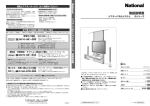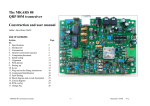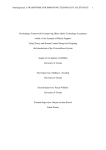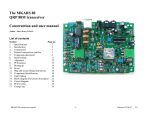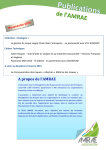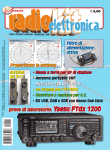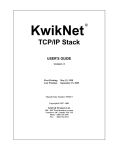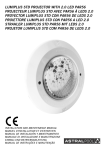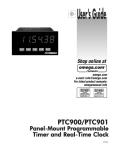Download Feb - Surrey Radio Contact Club
Transcript
SURREY RADIO CONTACT CLUB FEBRUARY 2010 – No: 809 CLUB NET 1.905 MHz CLUB Internet WEB Site: Sunday 9:30am Hon. Sec. Ray Howells G4FFY 16 Handel Walk TONBRIDGE Kent TN10 4DG 01732 357474 http://www.g3src.org.uk E-Mail: [email protected] MONTHLY MEETINGS 1ST AND 3RD MONDAYS 7.30 FOR 7.45pm Meetings at Trinity School, Shirley Park, Croydon CR9 7AT ********************************************************************************************* “A” MEETING 1st Feb 2010 Packet Radio with John G8MNY “B” MEETING 15th Feb 2010 FIX-IT, ADVICE, CHIN-WAG, CLUB STATION + "MOVE-IT-ON" Chairman & Club Meetings Vice-Chairman & Publicity Treasurer, Liaison & Equipment Secretary, Membership & Communications VHF Co-ordinator Committee Member Committee Member (Co-Opted) – Technical Recycling G4FDN Pat McGuinness G4WAY Roger Holyoake G4DDY Maurice Fagg G4FFY Ray Howells G8IYS John Simkins G3MCX John Kennedy G4XAT Gareth Evans G4DDY Maurice Fagg Dear Members & Friends Hello and welcome to the February 2010 Newsletter which is being edited Ray G4FFY. I’m afraid my time in January has been spent on the dreaded tax return which hopefully by the time you receive this Newsletter will be done and dusted! That should then give me time to start finally clearing the garage of the storage boxes and shifting what is not wanted. It is also Radio Fairs time again and we start preparing for the next Kempton Rally on Sunday 18th April 2010. We are also preparing the Motor Caravan for the new season and plan to finalise the aerial installation – any thoughts on a good HF mobile system would be appreciated. 73 Ray G4FFY This month’s meetings: For the “A” meeting on Monday 1st February 2010 we are pleased to welcome back at short notice John G8MNY who will be presenting a talk on Packet Radio, with the regular “Fix-It" and "Move-It On" Meeting on Monday 15th February 2010 NEXT "A" MEETING: Monday 1st Feb 2010 Packet Radio - John G8MNY 7:30pm for 7:45pm "We are pleased to have John G8MNY back to give us a talk on Packet Radio. As most people will be aware there has been a reduction in packet activity over recent years from its peak. However, it continues to endure and develop, with APRS just being one application that has come along. It is certain to be a very interesting evening, and hopefully will be a spur to get ‘re-connected’ on packet. If any member does want to get going again I’m sure there will be help, advice and encouragement from John at the following ‘B’ meeting. Pat G4FDN" Issue 2 – 27th Jan 2010 020 8643 0491 020 8689 7089 020 8669 1480 01732 357474 020 8657 0454 020 8688 3322 020 8462 2837 020 8669 1480 LAST "A" MEETING: Monday 4th Jan 2010 High Power LED’s & Sustainable Designs–G4XAT Gareth has kindly sent me a summary of his talk as follows: “Where did it all start? In 1975 with a 50pence LED that lasted all of ½ a second – an ‘illuminating’ talk by Gareth, G4XAT. I can even remember who I bought it from - Trampus Electronics – where are they now I wonder? This costly investigation was followed by purchasing a LM3909 LED flasher which I built into a key fob case and used for a few years. As an indication (sorry!) of how popular the chip would prove, they were still available 30 year later although now obsolete. The next time I needed a flasher to do the same thing I had to use a PIC!! Progress, what progress? During the 80’s red ultra-bright LEDs became available, and I even went as far as building a touch-controlled torch with a provisional patent application on it (to establish “prior art” is I believe the term). Unfortunately for my bank balance and future career neither Duracell (who were basking in the glory of how successful their clever Dura-beam torch was, which had 30% of the market at that time) nor Eveready could be tempted by the offering. Ironically it’s taken 20 years and the might of Chinese manufacturing to flood the market with decent LED torches. LED lighting has come of age and is here to stay, mainly driven by the need for less energy consumption and longer service life. Plus I prefer the light, and I like experimenting. To that end you could wastes several hours browsing the site http://www.instructables.com - search for LED lights and be amazed! Page 1 of 9 E&OE Power LEDs as such started to appear in the mid ‘noughties’ and Elektor Electronics published a comprehensive review of the offerings and performance in 2004 – how things have changed in 5 years! My son Joshua had need of a decent off-road bike light and after trying a 20 watt halogen we needed something better. Elektor came to the rescue again with a timely published circuit using a SMPSU chip from Linear Technology (who have been very helpful over the years with free samples for school). It worked, producing light levels well beyond commercial units costing £100’s. Things move on though and after several of the chips had died due to open circuit operation, I investigated driving them directly from AA NiMH cells. Although right at their upper limit of 1 amp forward current, I have over a 100 hours running on my unit and it shows no signs of deteriorating. The key is to keep them cool! Things never stay still for long in technology, and whilst browsing the internet I found a neat little driver IC that was clearly designed with power LEDs in mind. 8-32 volts in, 01.2 amps out (via a current sensing resistor), dimmable including total shutdown at less than 90uA drain, what more could you want? www.dealextreme.com supplied a set of 10 for a mere $2.38 each (free delivery) and experiments began again. The circuit is so small (surface mount) that it’s a bit fiddly to hack, but hack it I did and it’s robustness and flexibility will see it doing duty in a whole new range of lights. Like any SMPSU, it likes to broadcast its behaviour and some users report that it wipes out their FM car radio when used as an internal courtesy light replacement. Better RF design (capacitors at least) should clean them up enough to solve most problems. Bike Helmet LED Light There was more ‘padding’ in my talk but I’d be happy to expand on anything you want to know more about. My final note was on wall-warts (plug-top PSUs) and how I’d replaced some of my fleet with some nice units I found on eBay for a mere £2 each, rated at 12 volts and 2 amps. With the two I replaced on our cable modem and router we are saving some 30 watts, 24/7/356 which amounts to at least £20 a year. When you start to look it’s amazing how much is being wasted. What we need now is for the unit cost to come down to make it a financially worthwhile exercise. Only this time I hope it does not take the 20 years that CFL’s have taken to become reasonable!” Chairman’s Blog – February 2010 LED Desk Lamp I hope everyone has survived the recent extended period of snow without mishap - nothing though compared to 1963 (or 1947 I’m told). Last ‘A’ Meeting: This was a well attended presentation and talk on LED lighting by Gareth G4XAT. As most people will know, Gareth is a keen experimenter and constructor and nearly everything he brought along was a good example of his ingenuity. Gareth will have an article on LED lighting either in this issue or a later one. Jim Gale G4WYJ also brought along some examples of LED lighting for swimming pools. The pictures below were taken on the evening by John G8MNY. John has also contributed some design ideas on circuits to power and re-charge batteries for LED lighting, which will probably appear as part of Gareth’s article and is also available as a packet bulletin. Issue 2 – 27th Jan 2010 Page 2 of 9 Bike Handlebar LED Light E&OE Top Band Net: this continues to be enthusiastically supported on Sunday’s on 1.905 MHz LSB at 0930am. On the net, last Sunday, Martin G4FKK, reported completion of a PW Poppet 0.5W AM transmitter for Top Band and after the net this was aired on 1.942MHz to good effect after the club net had finished. Myself, Maurice G4DDY, and John G3ENG also came up on AM. Martin’s TX sounded very good and was 59+ with all participants. G8MNY Technical Bulletins: those on packet will be well aware of the large number of technical articles, covering the full spectrum of amateur activity that John has written. Less well known is that these are available on the internet. Some are listed at: http://skywaves.demon.co.uk/tech_articles.htm but the index hasn’t been updated for a while. Access to all of them (including some by other authors) in HTML directory format can be had via http://skywaves.demon.co.uk/technical/ We will have to see whether we can get them mirrored on the SRCC website to make them more accessible. For those of you wanting to get going on the 2m FM club net then John’s Full Wave Dipole design is recommended. Comparison tests have shown it to be superior to the Slim Jim. The article for this is located at http://skywaves.demon.co.uk/technical/Aerials/2M_Fullwave _Dipole.pdf Philips Commercial External LED Light Project for Construction Evening: this was mentioned in the last newsletter. Two proposals have been tabled so far. The first is a 25-30W outboard PA for an FM handheld based on the Mitsubishi RF power modules obtained by Maurice (or possibly 50-60W PA based on two modules – see design by G8MNY in the last newsletter). The second suggestion comes from Gareth G4XAT concerning a high power LED table/inspection lamp. If you have a preference for one or the other we will be taking a show of hands at the next meeting to gauge before the committee makes a decision. LumiPlus LED Pool Lighting 75th Anniversary Lunch: Just a reminder that this will be Last ‘B’ Meeting: Because of a mix-up over the meeting dates given to the Trinity Bursar, the meeting was held in the Rehearsal Room instead of the usual Sanderson Room. The meeting was the usual mix of chin-wag and fix it, with as usual, John G8MNY bringing along a wide range of test gear. held on the afternoon of Sunday October 10th 2010 (10/10/10 –an easy date to remember) at the Holiday Inn Hotel, Sutton between the Civic and Secombe Centres, and a short walk from Sutton railway station. Committee: We are pleased to welcome back Gareth G4XAT who has agreed to be co-opted. Also, the last meeting had Steve G4FYF in attendance as an observer, who was most welcome. I myself missed the meeting, which was chaired by Roger G4WAY, because of a flue like symptoms, which luckily had cleared up within 48 hours. 2M FM Net : An initial test for coverage was undertaken th on Sunday 24 January at 1015 on 145.35MHz FM, with myself and the following members taking part: G4FKK, G8MNY, G4XAT, G4DDY, G6JXA, G8TB and G3ENG. Everyone heard everyone else OK except Bernard G8TB and Gareth G4XAT. As an experiment, a net will be held on Friday evenings at 8pm on 145.35MHz (+ or – minus if busy or QRM), for the next few weeks to see if there is enough interest and momentum to keep it going. In particular, we are trying to encourage participation from M3/M6 licensees from Trinity school and other club members who for whatever reason are unable to get on Top Band. The club used to hold a net on this frequency and time in the 1970’s so this is in a way a revival of that. It should be noted that the Sunday Top Band net continues as normal. Issue 2 – 27th Jan 2010 The hotel also has free designated disabled parking for those attending. The time of the event and its location has been chosen to facilitate participation by ‘country members’. John G3MCX is in the process of contacting members to gain their commitment to support this important event in the club’s history. It would be helpful if members could confirm their attendance as soon as possible. Can I ask that any member who would like to attend, but anticipates travel difficulties could they discuss them with John G3MCX, and the committee what can be organised in terms of lifts or mini-buses. Page 3 of 9 E&OE th 80m AFS CW Contest 10 January: This was supported by Alun G4WGE, John G3BFP, John G3MCX, and Steve G4FYF. John G3BFP wrote “The four man team claimed a total score of 3730 points –not an award winner but we won’t be bottom!!” Operating: John G3BFP, as usual, kindly forwarded some log extracts. This month the amount of DX has been reduced somewhat but John still managed JT1CO (Mongolia) on 40m, ZL2AGY on 30m and HS0ZCY/4 (Thailand) on 17m. Anybody else doing any DXing, HF or VHF? Next ‘A’ Meeting: We are pleased to have John G8MNY back to give us a talk on Packet Radio. As most people will be aware there has been a reduction in packet activity over recent years from its peak. However, it continues to endure and develop, with APRS just being one application that has come along. It is certain to be a very interesting evening, and hopefully will be a spur to get ‘re-connected’ on packet. If any member does want to get going again I’m sure there will be help, advice and encouragement from John at the following ‘B’ meeting. Looking forward to seeing you all next Monday 1st February. 1st Mar 12th Apr 10th May 7th Jun Spring Surplus Equipment Sale AGM Project Constructing Project Evening Construction Contest SRCC Meetings indicated in BOLD at venue of Trinity School Rally Calendar, etc: 25th Canvey Radio & Electronics Rally 7th Feb ‘The Paddocks’’, Long Road, Canvey Island, SS8 0JA, Open 10:30 Parking, Catering, Disabled Facilities, Trade Stands. Contact: Dave, G4UVJ, 01268 697978 (evenings) www.southessex.ars.btinternet.co.uk 14th Feb th Harwell Radio and Electronics Rally Didcot Leisure Centre (Adjoining St. Birinus School), Mereland Road, Didcot, OX11 8AY, Oxfordshire. Contact: Ann Stevens 01235 816379 www.g3pia.org.uk e-mail [email protected] 28 Feb Rainham Radio Rally Rainham School For Girls, Derwent Way, Gillingham, Kent, ME8 0BX Contact Trevor, G6LYW, 0771 7678 795 SRCC and Local Club Meeting Dates: Packet Radio with John G8MNY 1st Feb th Sutton & Cheam RS – 'Natter Night' @ Vice 4 Feb 7th Mar Cambridge and District ARC Rally Wood Green Animal Shelter, King's Bush Farm, A1198 London Road, Godmanchester, Cambs PE29 2NH Contact David, M0GUM, 01954 203080 www.cdarc.co.uk e-mail: [email protected] 5th Feb 18th Apr Spring West London Radio & Electronics Show at Kempton Park – www.radiofairs.co.uk – Lecture stream – Opens 10am - £4 Rally List http://www.rsgb.org/events/index.php THE CALENDAR SECTION 8th Feb 12th Feb Presidents Lounge, Sutton United Football Club, Gander Green Lane, Sutton –8pm. Sec: John G0BWV 020-8644 9945 www.scrs.org.uk Crystal Palace: AGM @ All Saints Church Parish Rooms, Beulah Hill from 7:30pm. Bob G3OOU 01737 st 552170 (Meet normally monthly on 1 Friday) http://www.g3oou.co.uk/ CATS: How to Lose your SMD Virginity with Terry Giles G4CDY – Meetings normally held @ St. Swithun’s Church Hall, Grovelands Rd, Purley 8pm nd 2 Monday’s. Contact Andy Jackson G8JAC on 0208651 2727 [email protected] W&DARS: On Air and Construction @ Martin Way Methodist Church, Buckleigh Avenue, MERTON nd PARK SW20 9JZ – 7.30 for 8pm 2 & last Friday’s Details: Jim M0CON on 020-8874 7456 http://www.gx3wim.org.uk/ 15th Feb Fix-It, Advice, Chin-Wag, Move-It-On 16th Feb Bromley & District – Meeting Programme Planning. Meetings normally on 3rd Tuesday’s @ Victory Social Club, Kechill Gardens, Hayes – 7.30 for 8. Paul M3PGW [email protected] or www.bdars.org.uk Reigate Amateur Transmitting Society – Main meeting rd 3 Thursday’s at RNIB, Redhill College, Philanthropic Road, Redhill 7.30pm. www.qsl.net/rats or [email protected] Sutton & Cheam RS – introduction to Military Communications with Mike O’Beirne G8MOB @ Vice Presidents Lounge, Sutton United Football Club, Gander Green Lane, Sutton – 7.30 for 8pm. Sec: John G0BWV 020-8644 9945 www.scrs.org.uk Dorking & District Radio Society – Weak Sinal Propagation Reporter (WSPR), Walter Blanchard G3JKV. Meetings normally @ Friends Meeting House, Butterhill South Street, Dorking – opp. Spotted Dog. Details: David Smith M0SXD on 07808 579501, http://www.ddrs.org.uk or [email protected] W&DARS: Amateur TV by John Stockley G8MNY @ Martin Way Methodist Church, Buckleigh Avenue, nd MERTON PARK SW20 9JZ – 7.30 for 8pm 2 & last Friday’s Details: Jim M0CON on 020-8874 7456 http://www.gx3wim.org.uk/ th 18 Feb th 18 Feb 23rd Feb th 26 Feb Issue 2 – 27th Jan 2010 Web-Site of the Month From Charles M0BIN this month take a look at: Dick Cappels' Project Pages: http://cappels.org/dproj/Home.htm G3ASG - WW2 Memories of a Voluntary Interceptor: http://www.bbc.co.uk/dna/h2g2/brunel/u1600338 Radio Constructors Circuit Archive - Valve TRF: http://www.vintageradio.me.uk/radconnav/valvetrf/ Haminfo toolbar for your browser: http://www.haminfobar.co.uk/ New club for Morse code: http://www.essexcw.org.uk/ Web Hosting & Domain Name Registrations: http://billing.qth.com/index.php G3XBM QRP projects on U-tube: http://www.youtube.com/profile?gl=GB&user=G3XBM G3XBM QRP web site: http://www.g3xbm.co.uk/ G4TPH Magnetic Loop Antennas: http://www.g4tph.com/ Regen RX: http://groups.yahoo.com/group/regenrx/ More Web SDR's: http://websdr.ewi.utwente.nl:8901/ Updated GQRP Club web site: http://www.gqrp.com/tech.htm JAB Electronic Components: http://www.jabdog.com/index.htm Page 4 of 9 E&OE Pye MX294 Receiver Sensitivity Improvements by Pat McGuinness G4FDN These notes, not previously published, came about after discussions with Gareth G4XAT, on a recent club Sunday net. Gareth mentioned that he planned to get mobiling again on 2M FM with a MX294, but he was concerned about its apparent lack of sensitivity. I have experimented with MX294’s in the past so I share my findings and suggested mods from my notebook now so others can try them out. I no longer have the highband MX294’s I modded, so the photographs included here are from a lowband one I still have. The component layout is the same for both lowband and highband, though obviously component values vary. The MX294 has two main variants, one with a bipolar NPN front end transistor in the RF amplifier stage(board marked AT28790) and one with a dual gate MOSFET RF amplifier (board marked AT28873). In my opinion, the RF amplifiers in the MX294 are not insensitive per se; –they are just encumbered by lots of RF filtering, which in itself is not a bad thing, as it gives a wider margin of protection from out of band signal overload. But if your priority is sensitivity then the following modifications can give a worthwhile improvement. In carrying out the mods described here it is assumed that the reader has access to the MX294 circuit diagrams and description, or service manual, or The PMR Conversion Handbook by Chris Lorek and published by the RSGB, but I have included the essential parts of the circuit diagram in this article. It can be seen from the circuit diagram above for both MX294 variants that antenna changeover, done by diode switching is not done at the aerial connection point but after a 4-pole low pass filter that is common both to the TX and RX. This introduces a loss of around 1 to 1.5db on received signals, so if out of band rejection is less of a priority than sensitivity, then rearranging the antenna feed and switching can provide a useful improvement. This entails removing the diode switching, coupling and decoupling circuitry from the back end of the filter to the front end. This is not a task for a beginner as it requires both good de-soldering technique to remove the required components without damage to them or the printed circuit board. The modified arrangement is shown below. Issue 2 – 27th Jan 2010 Page 5 of 9 E&OE This is achieved by: • • • • • • • • • • • • Removing C141, D16, and C144 Making a small PCB to hold C141, D16, and C144 that has connections for miniature coax (RG174) in and out and ground, and for a wire connection to allow D16 to be biased. As there is insufficient space within the shielded RF compartments this is best mounted above the shield plate cover and fixed to the side of the radio’s chassis. The shield plate cover needs to be drilled with 3 small holes for the two miniature coaxial cables and the bias wire Cutting the PCB track between L28 and junction of D16, C141 Cutting the PCB track between the junction of C139, L29 and D16, C144 Cutting the PCB track between the junction of L34,C156,C157,R117 and the antenna socket Adding an insulated wire link from L27 to L31 Adding a small PCB containing C141,D16,C144 and connections for input, output and ground Connecting an insulated wire link between the junction of D16, C144 on the new PCB and C139, and L29 Connecting miniature coax inner (RG174) between junction of L34,C156,C157,R117 and C141 Connecting miniature coax shield (RG174) to ground adjacent to L34 Connecting miniature coax inner (RG174) between C144 and antenna socket connection Connecting miniature coax shield (RG174) to antenna socket ground If all connections have been made correctly (double check) it is time to test that the new antenna changeover arrangement has been made correctly. Connect power to the MX294 and switch on. Then connect a signal source and check the receiver is working OK. If so, then re-adjust L1 for best S/N on a weak signal. Then check the transmitter side and connect a dummy load and power meter and check that normal power out is achieved. An alternative to re-using the existing diode switching would be to use a miniature encapsulated changeover relay (9V to 12V), and this could be similarly fixed to the side of the radio chassis as per the diode switching PCB, and similar connections made for the miniature coax and wire for powering the relay (on for TX). This circuit arrangement is shown below. Relay A has a single pole C/O contact. Issue 2 – 27th Jan 2010 Page 6 of 9 E&OE As can be seen from the diagram above all the diode switching components have been removed. On transmit Relay A is energised and contact A1 changes over the antenna socket connection from the TX to RX. A further 1 to 1.5dB of loss reduction in the RX path can be achieved by modifying the tuned circuits at the input to the RF amplifier. The details for this are different for the BFQ51 and BF981 variants. Here is the unmodified circuit diagram for the BF981 variant: The modification involves removing one of the coupled tuned circuits on the input and re-arranging the connection point of g1 on TR1 (BF981). This reduces the loss from the antenna to TR1 by 1 to 1.5db. The modification is as follows: • • • • Remove C3, C4, and C6 Remove R1 Remove L2 (strictly speaking it can be left in situ, but no longer is used) Connect an insulated wire link from the junction of C2 & L1 to the former junction of C4, C6, R1 and g1 on TR1 (BF981) Issue 2 – 27th Jan 2010 Page 7 of 9 E&OE If all connections have been made correctly (double check) it is time to test. Connect power to the MX294 and switch on. Then connect a signal source and check the receiver is working OK, and then re-adjust L1 for best S/N on a weak signal. Though I did have an MX294 at one time with the BQF51 front end I did not get around to modifying it though I did write up the steps in my notebook. I will make this a subject of a future article in the club newsletter. 20 meter QRP transceiver – G4FYF I have been fancying building a QRP HF transceiver so set to work on a BITX design based on the Ashhar Farhan, VU3ICQ concept. I designed/etched separate boards, used ferrite cores instead of tap washers and IC voltage regulators instead of Zeners, and a Hartley VFO. Wired the boards together last night and with a bit of tweaking it sprang into life! It seems to be hearing pretty much as my trusty FT101ZD is but audio a bit tinny, possibly inadequate speaker. I was impressed with myself!! BPF Input/output/mixer/xtal filter VFO BFO/bal mod Mic/AF amps Now to get the TX FET PA up and running - I think I will need the G8MNY magic to peak everything for best performance! Then, find a box to put it in. Intended phase 2, a VFO stabiliser and digital frequency display (á la IK3OIL), this being a SMD project – boy, I’m really getting carried away now!! Having now taken this to the last B meeting, John, G8MNY, worked his magic and ripped some turns off the coils to tweak the response of the BPF. This has led to a lot of band ‘mush’ disappearing and signals becoming much more intelligible. Also confirmed the DBM was doing what it should do, so onward to the PA……… Steve Jones, G4FYF, Jan 2010 Issue 2 – 27th Jan 2010 Page 8 of 9 E&OE Programmable Frequency Counter - G4FYF This is my latest homebrew bit of test gear for the shack. It’s a frequency counter based on IK3OIL, PIC16F84, design and can be programmed with the following offsets: VFO+IF, IF-VFO, VFO-IF, and prescaler ratios. I also used this to try my hand at using SMDs for the first time. Wasn’t as difficult as I imagined and it functioned first time. This was also a first for producing a photo-etched PCB. The lowtech approach (from an idea by Eamon Skelton) using a 500W halogen lamp for the exposure. It worked remarkably well (after a bit of experimentation with exposure times), the small pads for the SMDs and fine tracks were all well defined after etching. All-in-all, a very worthwhile little project. The PDF for this is http://www.ik3oil.it/_private/Frequenzimetro_eng_2003.pdf; I obviously didn't use his PCD design. I also have the PIC code if anybody is interested. IK3OIL has a nice website that is worth a view: http://www.ik3oil.it/menu_eng.htm, click on 'projects' to find some useful stuff Steve Jones, G4FYF, Jan 2010 SIGNING OFF: That’s it for this month, apologies if I have missed anything while compiling this newsletter. For our main meeting on Monday 1st February we welcome back fellow club member John G8MNY for his talk on Packet Radio. The “B” meeting is on Monday 15th February. Don’t forget we now start at 7:45pm at Trinity School Many thanks for the Newsletter contributions from Pat G4FDN and Steve G4FYF – more always welcomed. Posted: 27th Jan 2010 73 and 88 Issue 2 – 27th Jan 2010 Page 9 of 9 E&OE










